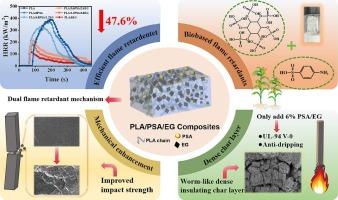Achieving anti-dripping and excellent flame retardancy in polylactic acid through a bio-based flame retardant/expandable graphite synergistic system
IF 6.3
2区 化学
Q1 POLYMER SCIENCE
引用次数: 0
Abstract
In this study, a novel bio-based flame retardant, phenylaminosulfonic acid phytate (PSA), was designed and synthesized. Then expandable graphite (EG) was introduced to construct a synergistic flame-retardant system (PSA/EG). This system was subsequently introduced into a polylactic acid (PLA) matrix via melt blending, and a PLA composite (PLA/PSA/EG) with anti-dripping and excellent flame-retardant properties was successfully prepared. Through systematic optimization of the PSA/EG ratio, it was found that incorporating only 6 wt% of a hybrid flame retardant composed of 3.6 wt% PSA and 2.4 wt% EG enabled the PLA material to achieve the UL-94 V-0 rating, with the limiting oxygen index (LOI) increasing from 19.7 % to 29.1 %. Based on experimental results of cone calorimeter, compared with pure PLA, the total heat release (THR), peak heat release rate (pHRR), and carbon dioxide production (PCO2P) of the PLA/PSA/EG composite were significantly reduced by 47.6 %, 43.8 %, and 50.3 %, respectively, illustrating outstanding flame-retardant performance. In addition, the thermal stability, crystallinity, and impact resistance of PLA had also been improved. This synergy provides new insights and strategies for the development of high-performance, environmentally friendly bio-based flame-retardant materials.

通过生物基阻燃剂/可膨胀石墨协同体系实现聚乳酸的防滴性和优异的阻燃性
本研究设计并合成了一种新型生物基阻燃剂——苯胺磺酸植酸酯(PSA)。然后引入可膨胀石墨(EG),构建增效阻燃体系(PSA/EG)。通过熔融共混将该体系引入聚乳酸(PLA)基体中,成功制备了具有防滴和优异阻燃性能的PLA复合材料(PLA/PSA/EG)。通过对PSA/EG比的系统优化,发现仅添加6 wt%的由3.6 wt% PSA和2.4 wt% EG组成的杂化阻燃剂,PLA材料就能达到UL-94 V-0等级,极限氧指数(LOI)从19.7%提高到29.1%。根据锥形量热仪的实验结果,与纯PLA相比,PLA/PSA/EG复合材料的总放热量(THR)、峰值放热率(pHRR)和二氧化碳产出量(PCO2P)分别显著降低了47.6%、43.8%和50.3%,表现出优异的阻燃性能。此外,PLA的热稳定性、结晶度和抗冲击性也得到了改善。这种协同作用为开发高性能、环保的生物基阻燃材料提供了新的见解和策略。
本文章由计算机程序翻译,如有差异,请以英文原文为准。
求助全文
约1分钟内获得全文
求助全文
来源期刊

European Polymer Journal
化学-高分子科学
CiteScore
9.90
自引率
10.00%
发文量
691
审稿时长
23 days
期刊介绍:
European Polymer Journal is dedicated to publishing work on fundamental and applied polymer chemistry and macromolecular materials. The journal covers all aspects of polymer synthesis, including polymerization mechanisms and chemical functional transformations, with a focus on novel polymers and the relationships between molecular structure and polymer properties. In addition, we welcome submissions on bio-based or renewable polymers, stimuli-responsive systems and polymer bio-hybrids. European Polymer Journal also publishes research on the biomedical application of polymers, including drug delivery and regenerative medicine. The main scope is covered but not limited to the following core research areas:
Polymer synthesis and functionalization
• Novel synthetic routes for polymerization, functional modification, controlled/living polymerization and precision polymers.
Stimuli-responsive polymers
• Including shape memory and self-healing polymers.
Supramolecular polymers and self-assembly
• Molecular recognition and higher order polymer structures.
Renewable and sustainable polymers
• Bio-based, biodegradable and anti-microbial polymers and polymeric bio-nanocomposites.
Polymers at interfaces and surfaces
• Chemistry and engineering of surfaces with biological relevance, including patterning, antifouling polymers and polymers for membrane applications.
Biomedical applications and nanomedicine
• Polymers for regenerative medicine, drug delivery molecular release and gene therapy
The scope of European Polymer Journal no longer includes Polymer Physics.
 求助内容:
求助内容: 应助结果提醒方式:
应助结果提醒方式:


